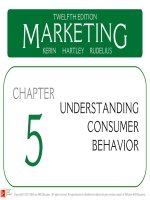Lecture Marketing (11/e): Chapter 7 – Kerin, Hartley, Rudelius
Bạn đang xem bản rút gọn của tài liệu. Xem và tải ngay bản đầy đủ của tài liệu tại đây (4.06 MB, 77 trang )
McGrawHill/Irwin Copyright © 2013 by The McGrawHill Companies, Inc. All rights reserved.
7-1
LEARNING OBJECTIVES (LO)
AFTER READING CHAPTER 7, YOU SHOULD BE ABLE TO:
LO1
LO2
Describe the nature and scope of world
trade from a global perspective and
identify the major trends that have
influenced world trade and global
marketing.
Identify the environmental forces that
shape global marketing efforts.
7-2
LEARNING OBJECTIVES (LO)
AFTER READING CHAPTER 7, YOU SHOULD BE ABLE TO:
LO3
LO4
Name and describe the alternative
approaches companies use to enter
global markets.
Explain the distinction between
standardization and customization
when companies craft worldwide
marketing programs.
7-3
HOW DELL, INC., BUILT A BILLION
DOLLAR BUSINESS IN INDIA
7-4
LO1
DYNAMICS OF WORLD TRADE
WORLD TRADE FLOWS
Global Perspective
• Trade Feedback Effect
• Countertrade
United States Perspective
• Gross Domestic Product (GDP)
• Balance of Trade
7-5
FIGURE 7-1 Leading countries in global
merchandise trade in terms of imports (U.S.)
and exports (China)
7-6
FIGURE 7-2 Porter’s diamond of national
competitive advantage: four key elements
on why some industries and firms in
different countries become world leaders
7-7
LO1
DYNAMICS OF WORLD TRADE
COMPETITIVE ADVANTAGE OF NATIONS
Porter’s “Diamond”
• Factor Conditions
• Demand Conditions
• Related and Supporting Industries
• Company Strategy, Structure, and Rivalry
Economic Espionage Act (1996)
7-8
Sony 3D TV and Bruno Magli Shoes
LO1
What element of Porter’s Diamond of
National Competitive Advantage?
7-9
MARKETING IN A BORDERLESS ECONOMIC WORLD
LO1
TREND 1—DECLINE OF ECONOMIC PROTECTIONISM
Protectionism
Tariffs
Quota
General Agreement on
Tariffs and Trade (GATT)
World Trade Organization (WTO)
7-10
LO1
MAKING RESPONSIBLE DECISIONS
Global Ethics and Global Economics—
The Case of Protectionism
7-11
FIGURE 7-3 Protectionism hinders world
trade when countries raise prices and limit
supply through tariff and quota policies
7-12
MARKETING IN A BORDERLESS ECONOMIC WORLD
LO1
TREND 2—RISE OF ECONOMIC INTEGRATION
European Union
• Euro
North American Free Trade
Agreement (NAFTA)
Asian Free Trade Agreements
7-13
FIGURE 7-4 The European Union in mid2012 consists of 27 countries with more
than 500 million consumers
7-14
MARKETING IN A BORDERLESS ECONOMIC WORLD
LO1
TREND 3A—GLOBAL COMPETITION
Global Competition
Strategic Alliances
7-15
FIGURE 7-A Global companies and
marketing strategy
7-16
MARKETING IN A BORDERLESS ECONOMIC WORLD
LO1
TREND 3B—GLOBAL COMPANIES
International Firms
Multinational Firms
• Multidomestic Marketing Strategy
Transnational Firms
• Global Marketing Strategy
• Global Brand
7-17
MARKETING IN A BORDERLESS ECONOMIC WORLD
LO1
TREND 3C—GLOBAL CONSUMERS
Global Consumers
7-18
MARKETING MATTERS
The Global Teenager—A Market of 2 Billion
Voracious Consumers with $250 Billion to Spend
LO1
7-19
MARKETING IN A BORDERLESS ECONOMIC WORLD
LO1
TREND 4—A NETWORKED GLOBAL MARKETPLACE
7-20
LO2
A GLOBAL ENVIRONMENTAL SCAN
CULTURAL DIVERSITY
Cross-Cultural Analysis
Values
Customs
• Foreign Corrupt
Practices Act (1977)
7-21
FIGURE 7-B Cultural appreciation
7-22
LO2
A GLOBAL ENVIRONMENTAL SCAN
CULTURAL DIVERSITY
Cultural Symbols
• Semiotics
#13
7-23
A GLOBAL ENVIRONMENTAL SCAN
LO2
CULTURAL DIVERSITY
Language
• Unintended Meanings
Nestlé
Ad
• Back Translation
Cultural Ethnocentricity
• Consumer Ethnocentrism
7-24
LO2
A GLOBAL ENVIRONMENTAL SCAN
ECONOMIC CONSIDERATIONS
Stage of Economic
Development
• Developed Countries: Japan
• Developing Countries
Made the Move:
Remain Locked:
Brazil
Tanzania
• Bottom of the Pyramid
7-25









